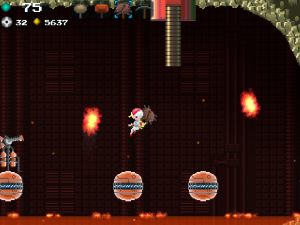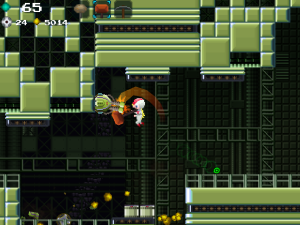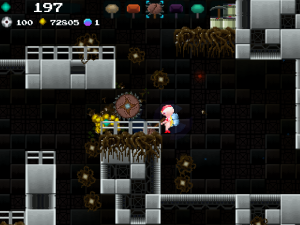Official Site || IndieGameStand Page || Steam Greenlight Page
NOTE: An updated version of Operation Smash is currently in development for Steam.
You might be able to guess from its name that Operation Smash involves swinging around a giant hammer, but you may be surprised to hear that it’s also a very open and fast-paced Metroidvania.
Operation Smash is not at all a game which feels a need to hold your hand when it comes to exploration. At the moment you first gain control of the protagonist, Gemma, you are defenseless and presented with two different paths to choose from in your search for a weapon; these paths soon prove to be a small, closed circuit leading to your first hammer, but they set a precedent for what to expect for the rest of the exploration in general. Though you may sometimes need a specific item to progress or may have a certain task to complete, you are almost never pointed towards an exact location nor even towards a general area. This lack of guidance does mean that you may sometimes end up fumbling through one region for a good chunk of time when the next major upgrade you need is actually somewhere else entirely, but you are unlikely to come away from such an expedition empty-handed as dozens of upgrades are scattered throughout the world and you’ll often find new shortcuts to unlock along the way.
Progression in Operation Smash is largely divided into two parts. The game begins with an entire class accidentally being transported millions of years into the past by a time machine, though Gemma arrives a few hundred years after everyone else only to discover that the time machine’s creator, Rusty, may have gone crazy and that everyone else in the class has been transformed into a spirit. The story largely serves as a means to an end for the platforming and you’ll spend the first part of the game stumbling across several of Gemma’s classmates as you flesh out the map, find teleporters, and collect most of the major upgrades in the game. Most of your actual exploration, and potentially most of your playtime, is likely to take place in this first upgrade-focused part. While most games would start to point players towards the final boss around the time they found the last of the mandatory upgrades, this is when Operation Smash instead launches into its second part.
 In a very similar way to Metroid Prime’s Chozo Artifact hunt, the second segment of Operation Smash involves backtracking throughout the world to find locations for several magical stones. The actual amount of backtracking through old content at this point is fairly minimal if you’ve already found the teleporter for each area, though it can become a bit tedious if you missed a teleporter somewhere or if you had already stumbled across one of these magic stone locations before being able to properly interact with it. In addition, the general setup for the plot comes more strongly into play here as you have the optional task of finding Soul Stones, which can be used on a classmate’s spirit to send them back to the present. This optional objective is technically possible to do at any point in the game, but many of the Soul Stones are hidden in completely unassuming wall and floor tiles and you are unlikely to find many of them without a certain optional late-game upgrade. Unlike the magic stone location hunt, the search for Soul Stones involves plenty of backtracking through old content as you will have to scour every last inch of the map to find them all and it quickly becomes clear that this objective is optional for a reason – it’s there to provide a bit more in the way of incentive and reward along the way if you’re aiming for a 100% item run and plan to backtrack around the map anyway, but it otherwise quickly becomes tedious on its own.
In a very similar way to Metroid Prime’s Chozo Artifact hunt, the second segment of Operation Smash involves backtracking throughout the world to find locations for several magical stones. The actual amount of backtracking through old content at this point is fairly minimal if you’ve already found the teleporter for each area, though it can become a bit tedious if you missed a teleporter somewhere or if you had already stumbled across one of these magic stone locations before being able to properly interact with it. In addition, the general setup for the plot comes more strongly into play here as you have the optional task of finding Soul Stones, which can be used on a classmate’s spirit to send them back to the present. This optional objective is technically possible to do at any point in the game, but many of the Soul Stones are hidden in completely unassuming wall and floor tiles and you are unlikely to find many of them without a certain optional late-game upgrade. Unlike the magic stone location hunt, the search for Soul Stones involves plenty of backtracking through old content as you will have to scour every last inch of the map to find them all and it quickly becomes clear that this objective is optional for a reason – it’s there to provide a bit more in the way of incentive and reward along the way if you’re aiming for a 100% item run and plan to backtrack around the map anyway, but it otherwise quickly becomes tedious on its own.
 With only a single boss and a selection of enemies which largely consists of several variations of a few types of robots and turrets with a handful of unique enemies here and there, combat in Operation Smash still feels fine, but opponents largely exist to knock you off of ledges or into environmental hazards more than as threats in and of themselves. Your primary method of attack is to rapidly swing your hammer and it is quite a useful swing at that as its arc can hit foes in nearly any direction around you, even ones which are slightly below you at the end of the swing. Many enemies also attack with projectiles which the hammer’s swing can deflect back at them or other opponents, though certain projectiles, such as those made of fire, cannot be affected in such a way. There are several hammers to find, but their difference generally lies in their utility rather than their damage, such as the Spike Hammer being able to fire off projectiles capable of blocking fire attacks once you find the charge upgrade and the Bounce Hammer allowing you to bounce off of the floor and walls to reach high areas. In addition to the various hammers, you also have grenades, which are sort of like a combination of Metroid’s bombs and missiles. Grenades can technically be used to damage enemies, but their primary form of use comes from placing them near a fragile wall or hitting them into a suspicious area with the hammer to reveal secret passages with their explosions. You can only hold a limited number of grenades, but this limit quickly becomes arbitrary as it is easy to quickly expand your capacity to such a degree that you can toss them around constantly and still have dozens remaining.
With only a single boss and a selection of enemies which largely consists of several variations of a few types of robots and turrets with a handful of unique enemies here and there, combat in Operation Smash still feels fine, but opponents largely exist to knock you off of ledges or into environmental hazards more than as threats in and of themselves. Your primary method of attack is to rapidly swing your hammer and it is quite a useful swing at that as its arc can hit foes in nearly any direction around you, even ones which are slightly below you at the end of the swing. Many enemies also attack with projectiles which the hammer’s swing can deflect back at them or other opponents, though certain projectiles, such as those made of fire, cannot be affected in such a way. There are several hammers to find, but their difference generally lies in their utility rather than their damage, such as the Spike Hammer being able to fire off projectiles capable of blocking fire attacks once you find the charge upgrade and the Bounce Hammer allowing you to bounce off of the floor and walls to reach high areas. In addition to the various hammers, you also have grenades, which are sort of like a combination of Metroid’s bombs and missiles. Grenades can technically be used to damage enemies, but their primary form of use comes from placing them near a fragile wall or hitting them into a suspicious area with the hammer to reveal secret passages with their explosions. You can only hold a limited number of grenades, but this limit quickly becomes arbitrary as it is easy to quickly expand your capacity to such a degree that you can toss them around constantly and still have dozens remaining.
The platforming in Operation Smash is very floaty and can take a few minutes to get used to, but the world is built with this floatiness in mind. Your vertical speed while jumping is slower than in most games, both when rising and falling, and the height of your jumps is average at best, but this is made up for when it comes to horizontal movement. You can cover an impressive amount of horizontal space in a single leap and, as Gemma is able to pick up speed when not obstructed, you can quickly cover the entire length of many rooms while only touching the ground once or twice. What’s more, your vertical movement is almost entirely negated while you are attacking an enemy, which can allow you to pull off some particularly tricky jumps and potentially sequence break in some locations. As to the map design itself, bounce pads are frequently present to make up for your relative lack of natural vertical jump height and many of the rooms are connected by long, narrow hallways which often require you to do some fairly precise platforming above lakes of lava or other environmental hazards while fending off enemy attacks.
 Though there is nothing outright broken in Operation Smash, it does have a few notable rough spots. Grenades can be buggy at times and, though it is uncommon, every now and then a grenade will simply refuse to explode no matter how long you wait and I even ran into an incident once where I used about a dozen grenades in a small area and, in addition to none of them exploding, the framerate plummeted until I moved into a different room. Menus could also use some work as both the start menu and the Game Over menu can, to the best of my knowledge, only be interacted with via mouse despite mouse controls otherwise not being present for the rest of the game; the map menu itself is fine, but it is tied to the escape key by default and it can take a while to realize that this extremely useful menu even exists. As for the teleport system, it’s always great to have one in a Metroidvania, but you’re probably going to be using the teleports very often in the later parts of the game and the fact that you need to teleport through them in a fixed loop rather than being able to simply choose which teleporter you wish to go to makes teleporting feel like a chore. Lastly, there is an issue with the music, not with the songs themselves (which are often catchy), but with the looping; just about every song in the game does not loop well and clearly fades in and out at its start and end with at least a few songs even containing several seconds of pure silence at their end before they start up again. Silence can be used well in games, but here it just feels jarring when paired with the upbeat soundtrack.
Though there is nothing outright broken in Operation Smash, it does have a few notable rough spots. Grenades can be buggy at times and, though it is uncommon, every now and then a grenade will simply refuse to explode no matter how long you wait and I even ran into an incident once where I used about a dozen grenades in a small area and, in addition to none of them exploding, the framerate plummeted until I moved into a different room. Menus could also use some work as both the start menu and the Game Over menu can, to the best of my knowledge, only be interacted with via mouse despite mouse controls otherwise not being present for the rest of the game; the map menu itself is fine, but it is tied to the escape key by default and it can take a while to realize that this extremely useful menu even exists. As for the teleport system, it’s always great to have one in a Metroidvania, but you’re probably going to be using the teleports very often in the later parts of the game and the fact that you need to teleport through them in a fixed loop rather than being able to simply choose which teleporter you wish to go to makes teleporting feel like a chore. Lastly, there is an issue with the music, not with the songs themselves (which are often catchy), but with the looping; just about every song in the game does not loop well and clearly fades in and out at its start and end with at least a few songs even containing several seconds of pure silence at their end before they start up again. Silence can be used well in games, but here it just feels jarring when paired with the upbeat soundtrack.
Even though it could use some polish in places, Operation Smash still stands as a remarkably solid Metroidvania. Your journey around its world never feels forced or blatantly guided and collectibles are constantly placed ever-so-slightly out of reach in nearly every room in the game. Floaty controls have ruined platformers in the past, but so much of the map is designed with these controls in mind that Gemma’s movement feels quick and refreshingly fluid rather than sloppy. With its creative mechanics and a surprisingly open world nearly overflowing with collectibles, I definitely recommend giving Operation Smash a try.